
Usnea is a genus of mostly pale grayish-green fruticose lichens that grow like leafless mini-shrubs or tassels anchored on bark or twigs. The genus is in the family Parmeliaceae. It grows all over the world. Members of the genus are commonly called old man's beard, beard lichen, or beard moss.

The Parmeliaceae is a large and diverse family of Lecanoromycetes. With over 2700 species in 71 genera, it is the largest family of lichen-forming fungi. The most speciose genera in the family are the well-known groups: Xanthoparmelia, Usnea, Parmotrema, and Hypotrachyna.
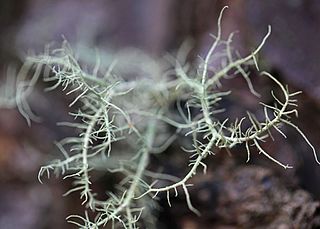
Usnea longissima, known by the name old man's beard or Methuselah's beard lichen, is a lichen in the family Parmeliaceae.

Allocetraria is a genus of lichenized fungi in the family Parmeliaceae. It consists of 12 species, with a center of distribution in China.
Józef Motyka was a Polish botanist and lichenologist.

A fruticose lichen is a form of lichen fungi that is characterized by a coral-like shrubby or bushy growth structure. It is formed from a symbiotic relationship of a photobiont such as green algae or less commonly cyanobacteria and one, two or more mycobionts. Fruticose lichens are not a monophyletic and holophyletic lineage, but is a form encountered in many classes. Fruticose lichens have a complex vegetation structure, and are characterized by an ascending, bushy or pendulous appearance. As with other lichens, many fruticose lichens can endure high degrees of desiccation. They grow slowly and often occur in habitats such as on tree barks, on rock surfaces and on soils in the Arctic and mountain regions.

Usnea filipendula, the fishbone beard lichen, is a pale gray-green fruticose lichen with a pendant growth form, growing in up to 20 cm many-branching tassels hanging from the bark of trees. In California, it mostly grows on mostly conifer in the Coast Range, but also in the western slopes of the Sierra Nevada range. It lacks apothecia. It is similar to Usnea scabrata, but is darker, has a thicker cortex, and different chemistry. Lichen spot tests are K+ red, KC−, C−, and P+ yellow.

Usnea strigosa, commonly known as bushy beard lichen, is a fruticose lichen in the family Parmeliaceae.

Usnea articulata, commonly known as the string-of-sausage lichen, is a pale greenish-grey, densely branched lichen with a prostrate or pendant growth form. It grows on bark, on branches and twigs, and is often unattached to a branch and merely draped over it. It grows up to 100 cm (40 in) in length.
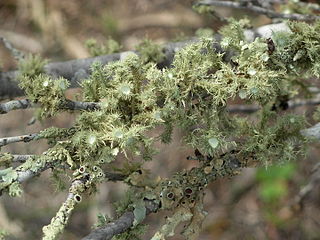
Usnea scabrida is a foliose lichen that grows from holdfasts on trees. It occurs in southwest Western Australia. It is a very pale grayish-yellowish green, slender, pendant, branching from the base, unequally branching, and shrubby. The cortex contains usnic acid, and the medulla contains scabrosins. The lichen was described as a new species in 1844 by English botanist Thomas Taylor.
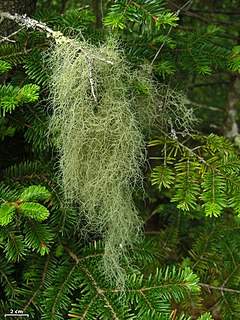
Usnea trichodea, commonly known as bony beard lichen, is a pale straw-colored fruticose lichen with a pendant growth form. It grows on trees and is native to eastern North America.

Vulpicida pinastri is a species of foliose lichen in the family Parmeliaceae. The lichen has a greenish-yellow thallus and dorsiventral lobes. It grows on conifers and Betula in North America and Eurasia. It is the only sorediate species in the genus and is distinguished by the bright-yellow marginal soralia. The lichen, originally described by Italian naturalist Giovanni Antonio Scopoli in 1772, was transferred to the newly circumscribed genus Vulpicida by Jan-Eric Mattson and Ming-Jou Lai in 1993.
Usnea glabrata is a species of beard lichen in the family Parmeliaceae. It was first described as a variety of Usnea plicata by Erik Acharius. Finnish lichenologist Edvard August Vainio transferred it to the genus Usnea in 1915. The lichen grows on bark and is widespread throughout Europe, although it is probably locally extinct in a few locations. It is characterized by small shrubby thallus, constriction of secondary branches at their base, presence of large soralia, and the absence of both papillae and isidia.
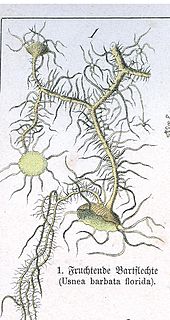
Usnea florida is a species of beard lichen in the family Parmeliaceae. It was first described by Carl Linnaeus in his 1753 work Species Plantarum. German botanist Friedrich Heinrich Wiggers transferred it to the genus Usnea in 1780. It is considered a threatened or vulnerable species in several European countries.

Usnea fulvoreagens is a species of beard lichen in the family Parmeliaceae. It was first described by Finnish lichenologist Veli Räsänen in 1931 as a variety of Usnea glabrescens. He raised it to distinct species status in 1935. The lichen has a shrubby thallus that is richly branched, and bases that are blackened. The presence of norstictic acid is often used to differentiate this species from other similar species. It has a widespread distribution in Europe.
Usnea glabrescens is a species of beard lichen in the family Parmeliaceae. It grows on bark, has a shrubby thallus with a blackened base, and a thick cortex. Several chemotypes of this species have been reported. The lichen is widely distributed in Europe.

Dolichousnea is a genus of fruticose lichens in the family Parmeliaceae. It has three species. The widely distributed type species, Dolichousnea longissima, is found in boreal regions of Asia, Europe, and North America.
Usnea vainioi is a rare species of beard lichen in the family Parmeliaceae found in the southeastern United States. It was described as a new species in 1936 by Polish lichenologist Józef Motyka. The specific epithet honours Finnish lichenologist Edvard August Vainio. The lichen contains diffractaic acid as the main secondary compound.
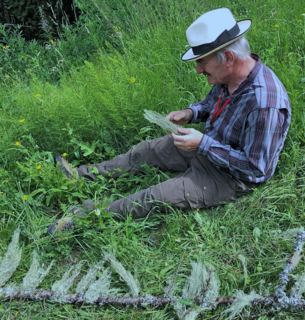
Philippe Clerc is a Swiss lichenologist. A Festschrift was dedicated to him in 2020, on the occasion of his retirement from the Conservatory and Botanical Garden of the City of Geneva, where he worked from 1993 to 2020. Clerc is an authority on the beard lichens, and has had nearly 100 publications on this and other topics, such as the lichen flora of Switzerland.

Jan Bystrek was a Polish botanist and professor of natural sciences. He was employed at the Department of Systematic and Geography of Plants at the Maria Curie-Skłodowska University from 1956 until 2004. He published research in many fields, including botany, floristry, lichenology, systematics, environmental protection, biogeography, ecology, bioindication, and nature and landscape protection. He was involved in popularizing knowledge about nature and ecological education.
















